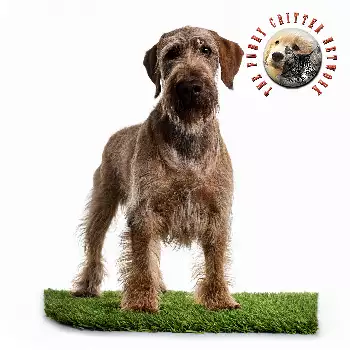Breed Standard
Head: Large, long. Skull not too broad .Stop not very pronounce . Slightly curved nosebridge. Long, angular muzzle. Brown nose. Prominent mustache and eyebrows.
Ears: Medium in size, lying flat, not curled.
Eyes: Large, rounded, yellow or brown.
Body: Long. Fairly long neck without dewlap. Chest not too broad. Ribs slightly curve. Broad loin. Sturdy back.
Tail: Carried level to the ground. Bushy hair but no plume. Usually docked by one-third or one-fourth.
Hair: Hard and harsh, much like a boar’s bristles. Bushy but not too long. ever curly or woolly. Fine, dense undercoat.
Coat: Preferably steel grey with brown markings or solid brown, often reddish-brown or roan. White and brown or white and orange also allowed.
Size: Dog: 55 to 60 cm (21.5-23.5 in).Bitch: 50 to 55 cm (19.5-21.5 in).
Weight: 20 to 25 kg (44-55 lb).
History
Eduard Karel Korthals is credited with the breed around 1873. Korthals' dream was to create the ideal versatile gun dog; one with extreme resiliency, vigor, and devotion to its master. The dog would also have to work close to its master, and be open to training.
Korthals' breeding line began in 1874 with "Mouche", who would be used as its foundation bitch, as well as five other dogs described as "Griffons": Janus, Satan, Banco, Hector, and Junon. He interbred the dogs carefully until offspring were produced that resembled his idea of an ultimate hunting dog. In any event, the resulting offspring (Moustache I, Lina, and Querida) are referred to as the "Korthals Patriarchs" because they are the Griffon's direct ancestors. In 1888 the first "griffon club" was formed as an international organization with local clubs in Bavaria "Southern German Griffon Clue" in 1895, in Belgium the "Royal Belgium Griffon Club" (1895) in France "French Wirehaired Griffon Club (1901) soon followed.
The American Kennel Club's first registered Korthals Griffons (called Wirehaired Pointing Griffon in the USA) was "Zolette", who was entered into the stud book in 1887. However, the Griffon was still relatively unknown, and she was registered as a "Russian Setter (Griffon)" for her presumed Russian heritage. It was not until 1916, twenty-nine years later, that the breed was officially recognized as the Wirehaired Pointing Griffon in the United States. In that same year, sixteen Griffons appeared in the Westminster Kennel Club Dog Show, one of the most prestigious shows in the country. Since then, the breed has grown in popularity as not only a show dog but also a versatile gun dog, Korthals' original intention for the breed. For the most part, the breed still resembles his original intentions: a medium size, harsh coat, good degree of trainability, and resilient on the field and in the ring.
Behavior
Vigorous, hardy, and enthusiastic, the French Wirehaired Pointing Griffon has a very subtle nose and can maintain a steady gallop. He is a multi-purpose pointer for all game, all types of terrain (from thickets to swampland), and any kind of weather. He is a good tracker, a firm pointer, and a good retriever. He is perfect on woodcock. Gentle, kind, and very attached to his owner, he is a good pet. However, he is strong-willed and a bit restless. He needs firm but not harsh training.
Most Griffons do not take well to living their lives in kennels. Regular exercise and training is highly recommended. They are extremely people oriented and prefer to be somewhere in the vicinity of their owners. The breed organizations recommend purchasing from breeders providing health clearances on written contracts on their guarantees. Recent research had discovered the infusion of another breed into the Griffon worldwide. This has caused a split in most countries between those individuals wishing to retain the genuine Korthals Griffon with the clubs recognizing all breedings including the outcross hybrids.
Contrary to some publications, the Griffon is not non-shedding. However, it does shed considerably less than many other breeds. All dogs shed, and it is the dog's dander and saliva that trigger most allergic reactions. Allergists do recognize that at times a particular allergy patient will be able to tolerate a particular dog (and many Griff owners consider these dogs hypoallergenic), but it may be that "the luck of the few with their pets cannot be stretched to fit all allergic people and entire breeds of dogs." Allergists "think there really are differences in protein production between dogs that may help one patient and not another", meaning that some allergic people may not have allergic reactions to a specific dog.
He is not well-suited to city life. He does not like being left alone or tied up. He needs lots of exercise every day, as well as brushing several times a week and regular attention to the ears.
Function
Hunting Dog, Companion Dog.
Health
Some of the breed are prone to hip dysplasia.






